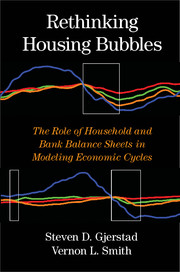 Rethinking Housing Bubbles
Rethinking Housing Bubbles Book contents
- Frontmatter
- Contents
- Acknowledgments
- 1 Economic Crises, Economic Policy, and Economic Analysis
- 2 Goods and Services Markets versus Asset Markets
- 3 Asset Performance
- 4 The Great Depression
- 5 The Postwar Recessions
- 6 What May Have Triggered or Sustained the Housing Bubble (1997–2006)?
- 7 The Bubble Bursts
- 8 Blindsided Experts
- 9 What Might Be Done?
- 10 Learning from Foreign Economic Crises
- 11 Summary: What Have We Learned?
- Index
- References
3 - Asset Performance
Housing and the Great Recession
Published online by Cambridge University Press: 05 June 2014
- Frontmatter
- Contents
- Acknowledgments
- 1 Economic Crises, Economic Policy, and Economic Analysis
- 2 Goods and Services Markets versus Asset Markets
- 3 Asset Performance
- 4 The Great Depression
- 5 The Postwar Recessions
- 6 What May Have Triggered or Sustained the Housing Bubble (1997–2006)?
- 7 The Bubble Bursts
- 8 Blindsided Experts
- 9 What Might Be Done?
- 10 Learning from Foreign Economic Crises
- 11 Summary: What Have We Learned?
- Index
- References
Summary
[B]eing the managers rather of other people’s money than of their own, it cannot well be expected, that they should watch over it with the same anxious vigilance with which…(they) frequently watch over their own.
– Adam Smith (Wealth of Nations, Book V, Chap. 1, Part III)In the 1950s, I went to work for a mortgage brokerage firm in LA. When my father learned about my new job, he expressed concern. “You’re not going to bundle them, are you? That’s what brought on the Depression.”
– Personal correspondence from William A. Fraser, Jr., April 7, 2009Real estate bubbles occurred frequently during the past thirty years in both developing and advanced economies. Reinhart and Rogoff (2008) evaluated five major developed-country financial crises: Spain in 1977, Norway in 1987, Finland and Sweden in 1991, and Japan in 1992. They found that, averaged across the five crises, residential real estate prices peaked a year before the onset of the financial crisis; house prices had fallen by 22 percent four years after they had peaked. Rogoff and Reinhart (2009) extended their earlier analysis to twenty-two financial crises in both developed and developing countries and found that real estate prices fell in all of them, with a median decline of 35.5 percent. House prices declined more than 10 percent in twenty of the twenty-two crises. They also found that a typical financial crisis is associated with a substantial increase in unemployment and a decline in GDP that lasts for several years, followed by a large increase in government debt. Although their analyses indicated that house-price declines, unemployment, and equity market declines are all associated with financial crises, they did not indicate which factor or factors might have triggered the downturns and which are effects.
- Type
- Chapter
- Information
- Rethinking Housing BubblesThe Role of Household and Bank Balance Sheets in Modeling Economic Cycles, pp. 49 - 84Publisher: Cambridge University PressPrint publication year: 2014


